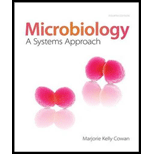
Microbiology: A Systems Approach
4th Edition
ISBN: 9780073402437
Author: Marjorie Kelly Cowan Professor
Publisher: McGraw-Hill Education
expand_more
expand_more
format_list_bulleted
Question
Chapter 13.3, Problem 19AYP
Summary Introduction
To differentiate:
Between the terms incidence and prevalence.
Concept introduction:
Disease incidence measures the number of new cases over a certain time period. The prevalence of a disease is the total number of existing cases with respect to the entire population.
Expert Solution & Answer
Want to see the full answer?
Check out a sample textbook solution
Students have asked these similar questions
its an open book assignemnt
Describe two different gene regulation mechanisms involving methylation
What is behavioral adapt
Chapter 13 Solutions
Microbiology: A Systems Approach
Ch. 13.1 - Prob. 1AYPCh. 13.1 - Identify the sites where normal biota is found in...Ch. 13.1 - Discuss how the Human Microbiome Project has...Ch. 13.2 - Prob. 2CFCh. 13.2 - Differentiate between a microbes pathogenicity and...Ch. 13.2 - Prob. 5AYPCh. 13.2 - List the steps a microbe has to take to get to the...Ch. 13.2 - Prob. 7AYPCh. 13.2 - Prob. 8AYPCh. 13.2 - Prob. 9AYP
Ch. 13.2 - Prob. 10AYPCh. 13.2 - Prob. 11AYPCh. 13.2 - Draw and label a curve representing the course of...Ch. 13.2 - Prob. 13AYPCh. 13.2 - List six different modes of horizontal...Ch. 13.2 - Define healthcare-associated infection, listing...Ch. 13.2 - List Kochs postulates, and explain alternative...Ch. 13.3 - Summarize the goals of epidemiology and the role...Ch. 13.3 - Identify why some diseases are notifiable, and...Ch. 13.3 - Prob. 19AYPCh. 13.3 - Discuss the three major types of epidemics, and...Ch. 13.3 - Prob. 21AYPCh. 13.3 - Prob. 22AYPCh. 13 - Prob. 1CFCh. 13 - Prob. 1MCQCh. 13 - Prob. 2MCQCh. 13 - Prob. 3MCQCh. 13 - Prob. 4MCQCh. 13 - Prob. 5MCQCh. 13 - Prob. 6MCQCh. 13 - Prob. 7MCQCh. 13 - Prob. 8MCQCh. 13 - A positive antibody test for HIV would be a...Ch. 13 - Prob. 10MCQCh. 13 - Prob. 11TFCh. 13 - Prob. 12TFCh. 13 - Prob. 13TFCh. 13 - Prob. 14TFCh. 13 - Prob. 15TFCh. 13 - Based upon data from the Human Microbiome Project...Ch. 13 - Prob. 2CTQCh. 13 - Prob. 3CTQCh. 13 - Prob. 4CTQCh. 13 - Prob. 5CTQCh. 13 - Prob. 6CTQCh. 13 - Prob. 7CTQCh. 13 - Prob. 8CTQCh. 13 - Prob. 9CTQCh. 13 - Prob. 10CTQCh. 13 - Prob. 1CCCh. 13 - Prob. 2CCCh. 13 - Prob. 3CCCh. 13 - Prob. 4CCCh. 13 - Prob. 5CCCh. 13 - Prob. 6CCCh. 13 - Prob. 1VCCh. 13 - Prob. 2VCCh. 13 - Appendix D provides guidance for working with...
Knowledge Booster
Similar questions
- 22. Which of the following mutant proteins is expected to have a dominant negative effect when over- expressed in normal cells? a. mutant PI3-kinase that lacks the SH2 domain but retains the kinase function b. mutant Grb2 protein that cannot bind to RTK c. mutant RTK that lacks the extracellular domain d. mutant PDK that has the PH domain but lost the kinase function e. all of the abovearrow_forwardWhat is the label ?arrow_forwardCan you described the image? Can you explain the question as well their answer and how to get to an answer to an problem like this?arrow_forward
- Describe the principle of homeostasis.arrow_forwardExplain how the hormones of the glands listed below travel around the body to target organs and tissues : Pituitary gland Hypothalamus Thyroid Parathyroid Adrenal Pineal Pancreas(islets of langerhans) Gonads (testes and ovaries) Placentaarrow_forwardWhat are the functions of the hormones produced in the glands listed below: Pituitary gland Hypothalamus Thyroid Parathyroid Adrenal Pineal Pancreas(islets of langerhans) Gonads (testes and ovaries) Placentaarrow_forward
- Describe the hormones produced in the glands listed below: Pituitary gland Hypothalamus Thyroid Parathyroid Adrenal Pineal Pancreas(islets of langerhans) Gonads (testes and ovaries) Placentaarrow_forwardPlease help me calculate drug dosage from the following information: Patient weight: 35 pounds, so 15.9 kilograms (got this by dividing 35 pounds by 2.2 kilograms) Drug dose: 0.05mg/kg Drug concentration: 2mg/mLarrow_forwardA 25-year-old woman presents to the emergency department with a 2-day history of fever, chills, severe headache, and confusion. She recently returned from a trip to sub-Saharan Africa, where she did not take malaria prophylaxis. On examination, she is febrile (39.8°C/103.6°F) and hypotensive. Laboratory studies reveal hemoglobin of 8.0 g/dL, platelet count of 50,000/μL, and evidence of hemoglobinuria. A peripheral blood smear shows ring forms and banana-shaped gametocytes. Which of the following Plasmodium species is most likely responsible for her severe symptoms? A. Plasmodium vivax B. Plasmodium ovale C. Plasmodium malariae D. Plasmodium falciparumarrow_forward
arrow_back_ios
SEE MORE QUESTIONS
arrow_forward_ios
Recommended textbooks for you
 Principles Of Radiographic Imaging: An Art And A ...Health & NutritionISBN:9781337711067Author:Richard R. Carlton, Arlene M. Adler, Vesna BalacPublisher:Cengage Learning
Principles Of Radiographic Imaging: An Art And A ...Health & NutritionISBN:9781337711067Author:Richard R. Carlton, Arlene M. Adler, Vesna BalacPublisher:Cengage Learning Issues and Ethics in the Helping Professions (Min...NursingISBN:9781337406291Author:Gerald Corey, Marianne Schneider Corey, Cindy CoreyPublisher:Cengage Learning
Issues and Ethics in the Helping Professions (Min...NursingISBN:9781337406291Author:Gerald Corey, Marianne Schneider Corey, Cindy CoreyPublisher:Cengage Learning- Case Studies In Health Information ManagementBiologyISBN:9781337676908Author:SCHNERINGPublisher:Cengage

Principles Of Radiographic Imaging: An Art And A ...
Health & Nutrition
ISBN:9781337711067
Author:Richard R. Carlton, Arlene M. Adler, Vesna Balac
Publisher:Cengage Learning


Issues and Ethics in the Helping Professions (Min...
Nursing
ISBN:9781337406291
Author:Gerald Corey, Marianne Schneider Corey, Cindy Corey
Publisher:Cengage Learning


Case Studies In Health Information Management
Biology
ISBN:9781337676908
Author:SCHNERING
Publisher:Cengage
